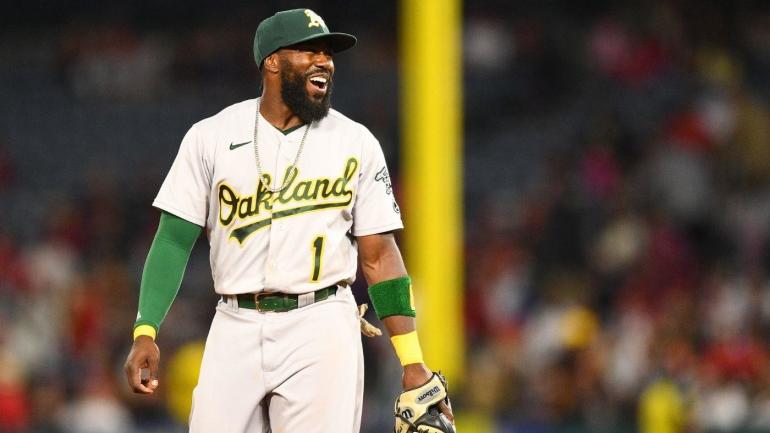MLB free agency: Why these seven under-the-radar players could prove surprisingly impactful next season
These players could make impacts in 2022, even if their signings aren't celebrated

Last week, CBS Sports published this year's top 50 MLB free agents list ahead of the official start of the offseason. Longtime Houston Astros shortstop Carlos Correa took the No. 1 spot as part of a star-studded class that features the likes of Corey Seager, Marcus Semien, Freddie Freeman, possible American League Cy Young Award winner Robbie Ray, as well as veterans Max Scherzer, Justin Verlander, and Clayton Kershaw.
The stars get all the headlines and all the biggest contracts, but everyone loves finding a bargain. We're certainly guilty of it; just last winter, we identified five under-the-radar players who seemed like potential value gets, including Anthony DeSclafani and two others who were part of postseason teams throughout the year.
Below, we've tried picking out seven winners from this winter's class. Let's get to it.
Ehire Adrianza made it onto last year's list following a rough 2020. He rebounded just fine, posting a 90 OPS+ as a switch-hitter for the Braves while seeing action at six positions. We figure he's likely to outpace his modest low-end salary once again.
Adrianza is a below-average hitter, but he does a couple of things well. He has a patient approach that sees him rarely expand the strike zone (his chase rate last season was 22 percent), and he has the bat control to maintain a contact rate around 80 percent. His offensive inadequacy is owed to his lacking strength; he's not one to sting the ball, especially when he's batting from the left side against righties.
As mentioned above, Adrianza is a versatile defender with enough arm strength to play on the left side of the infield. The Braves gave him more run in the outfield than he was accustomed to, but he can provide a team with coverage all around.
If Adrianza had just below-average power, he would be starting for someone. Instead, he's a utility reserve who can provide professional at-bats in a pinch.
Kole Calhoun technically finished last season below the replacement line, according to Baseball Reference's calculations. That was enough for the Diamondbacks to move on, declining his $9 million club option in favor of a $2 million buyout. Fair enough, but we have to admit that we think he can still serve as a platoon outfielder for someone.
For as uninspiring as Calhoun's topline numbers were (he had an 81 OPS+), he managed to hit .276/.340/.465 against right-handed pitchers. For comparison's sake, he had hit .227/.313/.463 versus righties over the three prior seasons. Calhoun's performance against righties the past three years puts him in the 61st percentile of wOBA, or ahead of Joc Pederson, Eddie Rosario, and David Peralta, each of whom appears likely to garner more interest than Calhoun will from contenders this winter.
There are some valid reasons for that, to be sure: Calhoun is 34 years old and he's never been particularly toolsy or graceful; with some careful micromanagement, though, he should be able to provide more value than last year's WAR indicates.
For clarity's sake, this Luis García is the one who pitched relief for the Cardinals. He did so beautifully, too, posting arguably the second-best season of his career despite not appearing in the majors until July.
García's salary is likely to be suppressed because no team wants to overpay an older pop-up reliever. It's wise to allow for the possibility of a player making legitimate improvements, however, and García seems to have done just that. He threw a career-high rate of strikes and nearly missed a career-high rate of bats over the course of his 33 innings. García's newfound success seems to stem from him leaning into a high-90s sinker-slider combination; those pitches play off each other well because of their mirrored spin.
García may not match last season's results pitch-for-pitch, but there's a fair chance he'll be underpaid relative to how he performs.
There's a class of player that has become underrated since exit velocity went mainstream. They don't hit the ball hard, but they provide value because of where they hit it (often in the so-called "sweetspot" window between 10 and 30 degrees). The Athletics are one of the teams who have gravitated to that profile, succeeding with bets on Robbie Grossman, Tommy La Stella, and Tony Kemp. The A's tried to do the same last deadline by acquiring Yan Gomes and Josh Harrison, but it didn't work out.
Harrison, best known for his versatility and his spark plug nature, revived his career with the Nationals during the pandemic. Last season, he saw his line crater from .294/.366/.434 (120 OPS+) to .279/.341/.400 (106 OPS+) after 199 plate appearances with Oakland. There was no apparent underlying explanation for the dip, so we're willing to write it off as a sample-size or luck thing. Nevertheless, teams are likely to hold that and his age (he's 34) against him, limiting him to another one-year deal.
A team embracing Beginner's Mind could look at Harrison and see an alternative to, say, Eduardo Escobar. Whereas Harrison ranked in the 90th percentile in batted balls hit in that aforementioned window and in the 18th percentile in balls hit 95 mph or harder; Escobar, our No. 41 free agent, was in the 79th and the 26th. It's not a perfect match, but then, their difference in salary may overstate the talent gap between them.
Jake Junis threw more than 500 innings over parts of five seasons with the Royals. During that time, he amassed a 94 ERA+ (about average for a starter) and a 3.25 strikeout-to-walk ratio, albeit with a bloated home-run rate. Some teams might still view him as a starter; we'd have interest in seeing him as a reliever.
Junis altered his slider last season, throwing it two miles per hour harder and reducing the active spin from 62 percent to 38 percent. That combination allowed him to miss a higher rate of bats (40 percent) and generate better in-play results. Junis was ineffective overall, however, because opponents hit .296 off his four-seam fastball and .370 against his cutter.
Our proposal, fittingly, would involve Junis minimizing his four-seamer and his cutter, and instead pairing his slider with his sinker (the fastball variant of his that best mirrors his slider's spin) during short spurts. Would it work? Maybe, maybe not; but it's probably worth the shot.
We feel obligated to include a caveat here: Junis dealt with shoulder issues last season, and it's entirely possible that his health is worse than we realize. If that's the case, then his pitch mix doesn't necessarily matter, now does it?
Daniel Norris has made his share of "breakout" lists and the like over the years. All he had to show for it last season was an unsightly 6.16 ERA (70 ERA+) and a career-worst 1.93 strikeout-to-walk ratio despite averaging a career-low amount of innings per outing. Are we delusional enough to include him here anyway? Clearly we are, folks.
Norris split the season between Detroit and Milwaukee. He made a notable pitch-mix tweak after joining the Brewers, reverting to using his changeup as his top secondary pitch, the way he had during 2020 (his best year to date). It was a move that made sense on paper, as Norris' changeup has been his best pitch (from in-play results and swing-and-miss perspectives) over the last three seasons. It didn't end up mattering one way or another because he stopped throwing strikes. Whoopsies.
Norris should keep that same blueprint heading forward and see what happens; assuming he can regain some of his control (and maybe that's a bad assumption to make), he has a chance to post another positive season in relief. (His changeup is a fascinating pitch, by the way: it features one of the highest amounts of seam-shifted wake among all the majors' cambios.)
You can be excused for scoffing at Gregory Polanco's inclusion. He hasn't been a positive factor since 2018 because of injuries and underwhelming play (he has a 70 OPS+ over the last three seasons). If you need evidence that his stock is now of the penny variety, consider that the lowly Pirates cut him in August, just weeks ahead of his 30th birthday. Still, we think he could provide surplus value as a platoon outfielder.
Last season, 49 percent of Polanco's batted balls had an exit velocity of 95 mph or harder, putting him in company with the likes of J.D. Martinez, Corey Seager, Franmil Reyes, Matt Olson, and other bonafide middle-of-the-order hitters. Impacting the ball isn't his problem so much as where he's hitting it; he's more prone to pop-ups and choppers than those individuals, reducing the potency of his quality contact. Perhaps a fresh start with a new organization will help him optimize his swing.
Even if Polanco doesn't make any changes, he should be in line for better results.





























